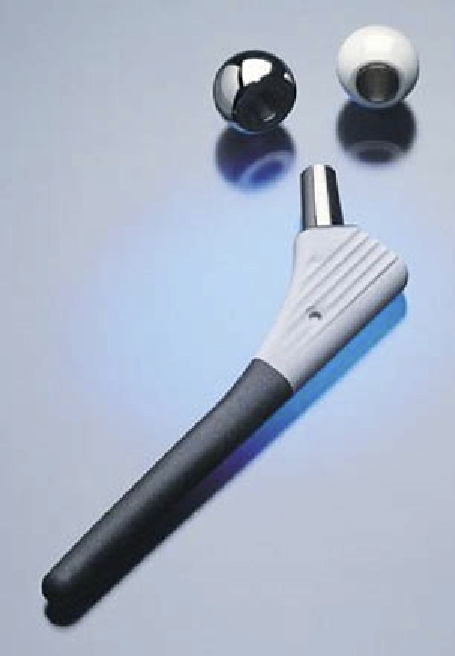Biomedical Engineering Reference
In-Depth Information
behavior of laminated carbon fiber/PEEK composite
hip stems (APC-2, ICI) in lactated Ringer's solution
for up to 120 days. In a separate study, the same
investigators also considered the effect of impact
loading during hammered insertion of their unce-
mented CFR-PEEK stems
[43]
. Researchers have
also employed numerical techniques, previously used
to design composites for aerospace applications, to
analyze CFR-PEEK hip stems
[44
e
50]
.
Several composite hip stem designs were
conceived by orthopedic manufacturers in this period
of experimental and analytical discovery. The Brad-
ley stem (Orthodynamics Ltd., Dorset, UK) was
developed in 1986 and implanted in 65 patients
between 1992 and 1998, according to information
available from the manufacturer. This composite
design consists of a tapered metallic core, with
a CFR-PEEK outer layer. The device is proximally
coated with hydroxyapatite (
Fig. 14.9
). The
biocompatibility of the CFR-PEEK composite
formulation used in the Bradley stem has been veri-
fied
[51]
, but the clinical results of the implant have
not yet appeared in the peer-reviewed literature.
Comparison of bone mineral density (BMD) 1 year
after surgery with postoperative scans in 10 patients
with isoelastic stems resulted in increased BMD in
Gruen zone 7 (personal communications with John
Bradley).
In the mid-1990s, researchers at DePuy-Dupont
Orthopedics developed a modular composite stem in
which the proximal metal body was fabricated from
porous-coated titanium alloy and the distal stem was
graphite-fiber-reinforced PEKK
[52]
. The PEKK
used in the stem was formulated by DePuy-Dupont
[53]
. Although a small clinical trial was performed
with this stem
[54]
, the clinical results have not been
published.
A new generation of isoelastic femoral stem, the
Physiologic stem, was also produced by Mathys
Medical (Switzerland). This consisted of a titanium
core sheathed in PEEK-OPTIMA and additionally
coated with a titanium layer. It has recently been
reported that 59 implantations of this stem have
occurred, with an average follow-up of 6.5 years
[55]
. Clinical and functional results were evaluated
by the Harris hip score, and the bone densities in
Gruen and Charnley zones were also measured. The
average Harris hip score improved from 40 (range
27
e
48) to 93 (range 89
e
95) with no observations of
aseptic loosening and an average Gruen score of 19
(range 17
e
21).
Figure 14.9
Bradley stem. Courtesy of Orthodynamics
Ltd. (Dorset, UK).
14.6 Stress Shielding in the
Acetabulum
The horseshoe-shaped anatomy and shallow
aspherical geometry of the acetabulum
[56
e
58]
is
clearly not reconstructed with fidelity in total hip
replacement
[59]
. In the case of cementless recon-
struction of the acetabulum, the superficial horse-
shoe-shaped articular surface and subchondral bone
are removed and involve reaming of bone on the
anterior and posterior facets. The facets have been
shown to be the primary load-bearing surfaces under
low loads, but also provide support along with the
acetabular roof under high loads
[57,60
e
64]
.
Following joint reconstruction, alterations in the
structural response of the pelvis have been reported
in numerous cadaveric experiments
[64
e
66]
and
computational FE studies
[63,67
e
72]
. Bay et al.
[65]
examined the contact pressures and strains in intact
pelvises compared with a reconstructed acetabulum.
Unlike the intact pelvis, contact was concentrated

